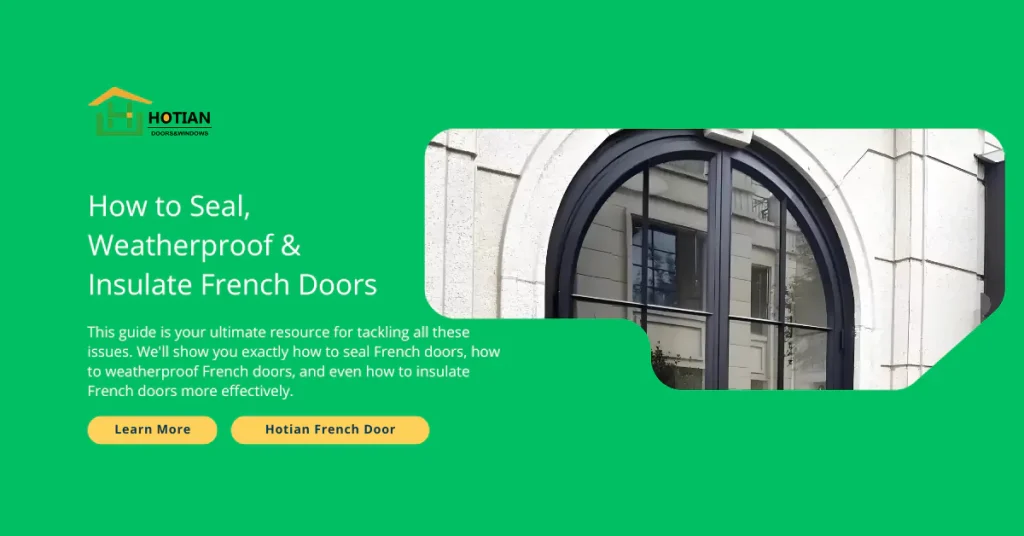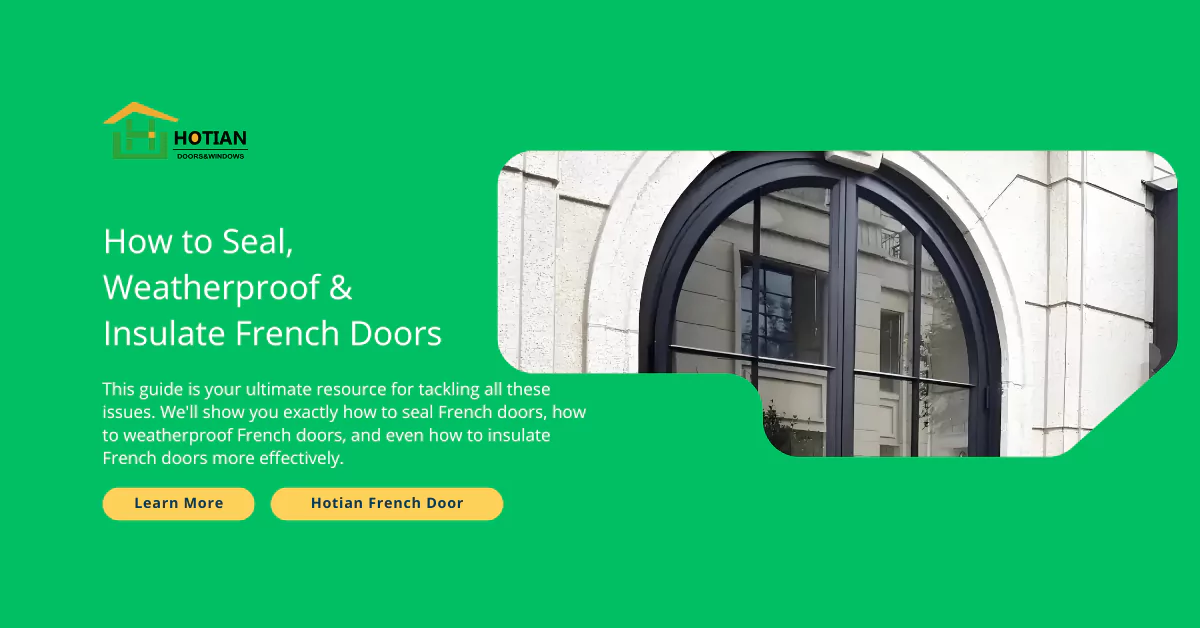French doors – they’re undeniably beautiful, right? Flooding rooms with light and adding that touch of elegance. (Want a reminder of their charm? Check out What Are French Doors?). But sometimes, their design – two doors meeting in the middle, lots of glass – can lead to some annoying problems.
Are you feeling drafts sneak in around the edges? Noticing pesky insects finding their way inside? Worried about water leaks during heavy rain? Maybe your energy bills seem higher than they should be? Or perhaps outside noise is more noticeable?
These are common challenges! People often ask, “Are French doors drafty?” or “Do French doors leak?” The answer is: they can be, especially if they’re older, weren’t installed perfectly (How to Install French Doors Guide covers proper installation), or haven’t been maintained.
But here’s the great news: you can fix it! Properly sealing, weatherproofing, and insulating your French doors brings amazing benefits:
- Save Money: Lower energy bills by stopping heated or cooled air from escaping.
- Boost Comfort: Eliminate chilly drafts in winter and keep heat out in summer.
- Protect Your Home: Prevent water damage from leaks.
- Keep Pests Out: Block entry points for bugs and critters.
- Reduce Noise: Improve sound insulation from the outside world.
This guide is your ultimate resource for tackling all these issues. We’ll show you exactly how to seal French doors, how to weatherproof French doors, and even how to insulate French doors more effectively. Let’s make those beautiful doors perform as great as they look!
Understanding French Door Anatomy & Vulnerabilities: Where Do Problems Start?
To fix the leaks and drafts, we first need to know where they usually happen.
A. Key Components (Relevant to Sealing):
- Stiles & Rails: The wood/fiberglass/etc., frame pieces of the door panels themselves.
- Glazing: The glass panes and the seals holding them in the door panel.
- Jambs & Header: The wood frame surrounding the doors in the wall (sides and top).
- Threshold (Sill): The bottom part of the frame you step over (exterior doors).
- Astragal: The vertical strip on one door that covers the gap where the two doors meet. Crucial for sealing!
- Weatherstripping: The fuzzy or rubbery strips around the door or frame designed to create a seal when closed.
B. Common Problem Areas (Where Drafts & Leaks Hide):
- Center Gap: The space where the two doors meet (between the astragal and the other door). This is often the #1 culprit for drafts!
- Bottom Threshold: The gap between the bottom edge of the doors and the threshold. Wear and tear here lets in drafts, water, and bugs.
- Door Perimeter: The gaps between the door panels and the side/top jambs where weatherstripping might be worn, compressed, or missing.
- Corners: Where vertical and horizontal seals meet (e.g., bottom corners, top corners) – these junctions can be tricky to seal perfectly.
- Glass Panel Edges: If the glazing seals around the glass panes fail, air and moisture can get in (sometimes between panes of double-glazed units).
- Hardware: Sometimes small gaps around handles or lock penetrations can allow minor drafts.
C. Signs Your French Doors Need Attention: Listen to Your Doors!
How do you know if sealing is needed? Look for:
- Visible Light: Close the doors (at night is best). Can you see light coming through cracks around the edges, bottom, or middle?
- Feeling Drafts: On a cool or windy day, run your hand around the edges. Feel cold air? You’ve found a leak!
- Water Stains/Damage: Any discoloration, soft wood, or peeling paint near the bottom of the doors or frame? Clear sign of water leaks.
- High Energy Bills: If your heating/cooling costs seem excessive, poorly sealed doors and windows could be major contributors.
- Noise: Can you easily hear outside conversations or traffic through the closed doors? Better sealing helps with sound too.
- Condensation: Fog or moisture between the panes of double-glazed glass means the seal has failed (needs repair/replacement – see French Door Repair Guide). Condensation on the inside surface might just mean high indoor humidity, but can be worse near cold drafts.
- Bugs Inside: Finding ants or other insects near the doors? They’re sneaking through tiny gaps!
D. Assessment Methods: Playing Detective
- Visual Check: Look closely at weatherstripping – is it torn, flattened, or missing? Check caulk around the exterior frame – cracked or peeling?
- Light Test: As mentioned, darkening the room and shining a flashlight from outside (or vice versa) highlights gaps.
- Smoke Test: Carefully use a smoke pencil or incense stick near the edges on a windy day. Watch where the smoke gets blown – that’s where air is leaking in/out.
- Water Test: Have someone spray water from a hose (gently!) around the outside edges while you watch from inside for drips. Use caution to avoid causing damage if you already suspect a bad leak!
Energy Efficiency and Environmental Considerations
Sealing isn’t just about comfort; it’s about saving energy!
- Are French doors energy efficient? They can be, especially modern fiberglass or vinyl ones with insulated cores and good glass packages (double/triple pane, Low-E coatings). However, their multiple seams (around two doors, center gap) mean proper sealing is MORE critical than for a single solid door. Older wood French doors are often less efficient without upgrades.
- vs. Sliding Doors: Are sliding doors or French doors more energy efficient? It depends heavily on the quality and sealing! High-quality versions of both can be efficient. Sliders have fewer seams overall (just around one moving panel usually), which might give them a slight edge if all else is equal. But poorly sealed sliders leak plenty too! Good weatherstripping is key for both. See a general comparison in French Doors vs Sliding Doors Guide (though it focuses more on cost).
- Impact: Stopping drafts can significantly reduce how hard your furnace or AC has to work, saving you money and reducing your home’s carbon footprint.
Essential Materials and Tools: Your Sealing Toolkit
Having the right stuff makes the job easier and more effective.
A. Weather Stripping Options (The Seal Makers):
- Compression Strips (Foam, Rubber, Vinyl): Squishy strips that compress when the door closes against them. Good for door jambs/stops. Comes in adhesive-backed rolls.
- V-Strip (Tension Seal): Plastic or metal strips that fold into a ‘V’ shape and spring open to fill gaps. Often used in door jamb channels. Durable.
- Door Sweeps/Bottom Seals: Attach to the bottom edge of the door panel.
- Brush Sweeps: Bristles block drafts and bugs.
- Rubber/Vinyl Sweeps: Flexible fin(s) create a seal against the threshold.
- Automatic Sweeps: Mechanically drop down to seal when door closes, lift up when opened (good for smooth floors).
- Foam Tape: Simple adhesive-backed foam strips. Easy to apply but may not last as long as compression types. Good for temporary fixes or small, consistent gaps.
- Specialized Astragal Seal: Weatherstripping designed specifically for the edge of the active door or the astragal itself to seal the center gap.
B. Sealing Materials (The Gap Fillers):
- Caulk: For sealing stationary gaps, like between the door frame and the house wall (exterior) or trim (interior).
- What kind of caulk for French doors? For exterior, use a high-quality 100% Silicone or Polyurethane caulk labeled for “Window, Door & Siding” – flexible, waterproof, durable. For interior trim, paintable Latex or Siliconized Latex caulk is usually fine.
- Expanding Foam Sealant: Use ONLY low-expansion “Window & Door” foam in the gap between the rough opening studs and the door frame (applied before trim goes on during installation, or carefully injected if accessible). Regular foam expands too much and can bow the frame!
- Weatherproof Tape/Membranes: Used behind the exterior frame during installation (flashing tape) to block water. Not usually applied after installation unless doing repairs.
C. Insulation Products (Boosting Thermal Performance):
- Window Film (Insulating Type): Clear film applied to glass that helps reduce heat transfer (summer and winter). Can be DIY kits (heat-shrink type) or professionally installed thicker films.
- Thermal Curtains/Drapes: Heavy, lined curtains hung over the doors (on a rod above) significantly reduce heat loss/gain.
- Draft Stoppers (“Snakes”): Fabric tubes filled with insulating material placed at the bottom of the door. Simple, temporary fix for floor drafts.
D. Soundproofing Materials (Quieting Things Down):
- Acoustic Weather Stripping: Denser rubber/silicone seals designed to block sound better than standard foam.
- Sound-Dampening Curtains: Very heavy, specialized curtains designed to absorb sound waves.
- Mass Loaded Vinyl (MLV): Heavy, flexible material sometimes added behind drywall or used in custom door panels for serious soundproofing (advanced).
E. Tools Needed:
- Tape Measure, Pencil
- Utility Knife, Scissors, Putty Knife (for removing old caulk/weatherstrip)
- Screwdriver/Drill (for installing sweeps/hardware)
- Caulking Gun
- Hammer (for minor adjustments/tacking)
- Cleaning Supplies (rags, rubbing alcohol for surface prep)
- Safety Glasses, Gloves
F. Budget Considerations:
- Low Cost ($5 – $25): Foam tape, basic vinyl sweeps, latex caulk, draft stoppers, DIY window film kits.
- Mid-Range ($25 – $75): Good quality compression weatherstripping, V-strip, silicone caulk, adjustable thresholds.
- Higher Cost ($75 – $300+): Multi-point lock systems (often improve sealing), high-end sweeps/thresholds, professional window film, thermal curtains, replacing astragals.
- Best ROI: Often, simply replacing worn-out perimeter weatherstripping and adding a good door sweep provides significant improvement for moderate cost.
Comprehensive Sealing Techniques by Door Area: Zone Defense!
Let’s tackle those problem areas one by one.
Zone Defense for French Door Sealing
Visual guide to the key areas that need sealing
A. Center Gap Sealing Methods: The Middle Ground
This is often the draftiest spot! How to seal between French doors?
- Check/Replace Astragal Seal: Inspect the existing weatherstripping on the astragal (if present) or where the active door meets the astragal. Is it worn, torn, or flattened? Replace it with a new strip of appropriate kerf-in or adhesive-backed weatherstripping.
- Improve Flush Bolt Seals: Ensure the flush bolts hold the inactive door tightly against the active door/astragal when engaged. Sometimes adjusting the strike plates helps.
- Add Weatherstripping: If there’s no seal or it’s inadequate, add a strip of adhesive-backed compression or foam weatherstripping along the edge of the active door where it meets the inactive door/astragal. Choose a thickness that fills the gap without making the door hard to close.
- Temporary Fixes: For seasonal drafts, sometimes placing a narrow strip of foam backer rod (used for caulking) into the gap can help temporarily.
- Address “How to stop draft between French doors”: Focus on a good seal along the entire vertical length where the doors meet. An intact astragal seal is usually the best solution.
B. Bottom Threshold Sealing: Stop Floor Drafts & Water!
How to seal bottom of French doors? Usually with a door sweep or threshold seal.
- Install/Replace Door Sweep:
- Measure: Measure the width of each door panel.
- Choose Type: Brush sweeps are good for uneven surfaces. Vinyl/rubber fins provide a tighter seal but can drag on carpet. Automatic sweeps lift up, avoiding drag.
- Install: Cut sweep to length. Hold against the inside bottom edge of the door (usually). Mark screw holes. Pre-drill small pilot holes. Screw sweep securely. Adjust height so it makes light, even contact with the threshold when closed.
- Adjust/Seal Threshold: Some thresholds have screws allowing you to raise/lower them slightly for a better seal. Ensure caulk between the threshold ends and the side jambs (exterior) is intact.
- Waterproofing Threshold: To stop water coming in under French doors, ensure the threshold is sloped correctly (away from inside), the sill pan underneath (installed during door installation) is intact, and the seal between the threshold and door bottom (sweep) is good. Waterproofing a French door threshold often involves ensuring these elements are working together. Exterior caulk along the front edge where threshold meets patio/deck can also help shed water away from the seam.
C. Perimeter Weatherstripping Methods: Sealing the Edges
How to seal around French doors? By ensuring good weatherstripping contact with the jambs and header.
- Inspect & Replace: Check existing weatherstripping in the frame (or sometimes on the door edge). If damaged, pull out the old strip (it might be held in a groove called a “kerf” or be glued/stapled). Clean the groove/surface. Press or slide in new weatherstripping of the same type/size. Cut neatly at corners.
- Add Weatherstripping: If none exists (common on older interior doors you want to seal), apply adhesive-backed compression foam or rubber seals to the door stop strips on the frame where the door closes against.
- Corner Seals: Gaps often occur where jamb and threshold/header weatherstripping meet. Small, self-adhesive foam corner seal pads can be placed here to block drafts. Where do you add corner seals on double French doors? Primarily at the bottom corners on the hinge and latch sides, and potentially the top corners as well.
- Caulking Frame: Where should I caulk my French doors? On the EXTERIOR, caulk the seam where the outside edge of the door frame/trim meets the house siding/brick. Do NOT caulk the bottom edge of the frame where it meets the threshold flashing – this allows trapped water to escape. On the INTERIOR, you can caulk where the trim meets the wall for looks, but this doesn’t usually affect drafts significantly.
D. Glass Panel Sealing and Insulation: Clear Views, Less Transfer
- Check Glazing Seals: Look for cracked or missing putty/glazing beads holding the glass. Re-glaze if necessary (how to glaze French doors – usually involves removing old putty, cleaning, applying new glazing compound, and smoothing).
- Insulate Glass: Apply insulating window film following kit instructions. This reduces heat transfer. For more insulation, consider thermal curtains hung on a rod above the doors.
Comprehensive Weatherstripping Installation and Replacement: The How-To
Let’s focus on the most common task: replacing worn weatherstripping.
Weatherstripping Installation Guide
A visual reference for French door weatherstripping
Types of Weatherstripping
Removal Process
Installation Techniques
Special Door Areas
- How to weatherstrip French doors: Identify the type you have (kerf-in, adhesive, stapled).
- Removal: Carefully pull out old kerf-in strips. Gently scrape off old adhesive strips (use adhesive remover if needed). Pry out staples. Clean the surface thoroughly (rubbing alcohol helps remove residue).
- How to apply weather stripping:
- Kerf-in: Start at one end, push the barbed edge into the groove in the frame. Work along the length, pressing firmly. Cut excess at the end with shears/utility knife.
- Adhesive-backed: Cut to length. Peel back a few inches of backing paper. Align carefully and press onto clean, dry surface (usually the door stop). Continue peeling backing and pressing firmly as you go.
- Replacing Specific Areas:
- How to replace weatherstripping between French doors: Replace the seal on the astragal or the edge of the active door where they meet.
- How to replace weather stripping on bottom of French doors: Usually involves replacing the door sweep attached to the door panel itself.
- Aluminum Astragal: Might have a specific channel for a slide-in vinyl or rubber seal. Identify the profile and find matching replacement seal.
Draft Prevention Strategies: Stopping the Breeze
How to stop draft from French doors? How to fix drafty French doors?
- Seal the Gaps: Apply/replace weatherstripping around perimeter, center gap, and bottom (Sections V & VI). This is the primary solution!
- Check Alignment: If doors are sagging or misaligned, they won’t compress the weatherstripping evenly. Adjusting the doors (How to Adjust French Doors Guide) is crucial for a good seal. How to adjust French doors to stop draughts? Focus on getting reveals even and ensuring the door closes squarely against the stops.
- Tighten Hardware: Ensure locks pull the doors tightly closed against the seals.
- Specific Drafts:
- How to stop bottom draft: Install or adjust door sweep. Check threshold seal. Use temporary draft stoppers.
- How to stop draft between French doors: Ensure astragal seal is good. Add weatherstripping if needed. Check door alignment. What to use for draft between French doors? Compression or V-strip weatherstripping, or specialized astragal seals.
Water Leak Prevention and Repair: Keeping Dry
Do French doors have water problems? They can if not installed or sealed correctly!
How to fix leaking French doors / How to stop French doors from leaking?
- Identify Source: Is water coming under the threshold? Around the frame? Through failed glass seals? Use the water test (carefully!) if needed.
- Threshold Leaks: How to stop water coming in under French doors? Ensure sill pan/flashing is intact (hard to fix post-install, may need pro). Check door sweep contact. Ensure threshold is caulked properly at side jambs and slopes away from inside.
- Frame Leaks: Check exterior caulk seal between frame/siding. Ensure flashing above the door (drip cap) is installed correctly.
- Flashing: Proper flashing installed during installation is key. How to flash French door? Involves layers of flashing tape and often a metal drip cap integrated with the house wrap behind the siding/trim. Retrofitting flashing is difficult and usually requires removing exterior trim/siding – often a pro job.
Insulating French Doors for Energy Efficiency
How to insulate French doors?
- Seal Air Leaks First! Stopping drafts (weatherstripping, caulk) provides significant insulation benefit.
- Insulate Glass: Apply insulating window film.
- Add Layers: Use heavy thermal curtains/drapes.
- Material Matters: Doors with insulated cores (fiberglass, steel) are inherently better insulators than solid wood or hollow core.
- Winterizing: How to insulate French doors for winter / How to winterize French doors? Apply window film, use draft stoppers, hang thermal curtains. Ensure all weatherstripping is in top shape before cold weather hits. How to seal French doors for winter? Focus on stopping all cold air drafts.
- Summer: How to keep heat out French doors? Window film (especially Low-E types that block solar heat gain), light-colored thermal curtains can help reflect sun.
Bug-Proofing French Doors: Uninvited Guests
- Seal Gaps: Use fine-bristle or tight-sealing vinyl door sweeps. Ensure perimeter weatherstripping has no gaps, especially at corners. Use caulk for tiny frame gaps.
- Screens: Adding screen doors outside your French doors is the most effective way to enjoy fresh air without bugs (Can French Doors Have Screens? Guide exists, link if appropriate/needed). Self-correction: Cluster 6, Article 1 covers screens.
Soundproofing French Doors: Peace and Quiet
How to soundproof French doors?
- Airtight Seal is Key: Sound travels through air gaps. Use dense, heavy-duty acoustic weatherstripping around the perimeter and center gap. Ensure a tight seal at the threshold.
- Add Mass: Heavier materials block more sound. Solid core doors are better than hollow core. Adding layers like heavy sound-dampening curtains helps significantly. Applying Mass Loaded Vinyl (MLV) is an advanced option.
- Glass: Double or triple pane glass helps. Laminated glass (used for security) also offers good sound reduction.
- Interior Doors: How to soundproof interior French doors? Use solid core doors if possible, add dense weatherstripping around the frame stops, and use a good door sweep/threshold seal if there’s a gap at the bottom.
Special Applications and Considerations
- Exterior Doors: Always use durable, UV-resistant, waterproof materials (exterior caulk, weatherstripping rated for outdoor use). How to weatherproof exterior French doors? Layering protection (flashing > caulk > weatherstripping > sweep) is key.
- Old Doors: How to weatherproof old French doors? Might require more surface prep. Gaps might be uneven, requiring thicker or multiple types of weatherstripping. Focus on gentle cleaning and using flexible seals.
- Storm Prep: How to protect French doors from hurricanes? Impact-rated doors/glass are best. Temporary solutions include storm shutters or rated plywood covers properly anchored. Basic sealing helps against wind-driven rain but not impacts.
DIY vs. Professional Solutions: Know Your Limits
- Good DIY Projects: Replacing adhesive/kerf-in weatherstripping, installing most door sweeps, applying basic caulk, using draft stoppers, applying DIY window film.
- Consider Pro Help For: Diagnosing persistent or complex leaks, flashing installation/repair, replacing thresholds, installing complex multi-point locks (which affect sealing), reglazing multiple panes, addressing potential structural issues causing misalignment.
Maintenance and Long-Term Care: Keep it Sealed!
- Inspect Seasonally: Check weatherstripping for wear, caulk for cracks, sweeps for contact.
- Clean: Wipe down weatherstripping occasionally. Clean door sweep area.
- Lubricate: Lightly lube hinges/latches if needed (can affect closure).
- Replace Promptly: Don’t wait for seals to completely fail! Replace worn weatherstripping or sweeps as soon as you notice damage for continued protection.
Troubleshooting Common Issues: Quick Fixes
- Door Hard to Close After Sealing? Weatherstripping might be too thick. Try a slightly thinner profile. Ensure it’s seated correctly in its channel/groove.
- Sweep Drags Too Much? Adjust sweep height slightly upward. Ensure threshold is clean.
- Draft Still Coming From Corner? Add a corner seal pad or ensure weatherstripping meets tightly there.
FAQ and Common Questions
Q: Are French doors drafty by design?
A: Not necessarily! Well-made, properly installed, and well-sealed modern French doors can be very energy efficient. Older or poorly maintained ones are often drafty due to seal failure or misalignment.
Q: Which is more energy efficient: sliding or French doors?
A: High-quality versions of both can be efficient. French doors have more seams needing good seals; sliders might have less potential leakage area but rely heavily on the seal where panels meet/slide. Quality and sealing matter most.
Q: Do all French doors leak?
A: Absolutely not! Proper installation with correct flashing, sill pan, and sealing prevents leaks. Leaks indicate a problem with one of these elements or failed seals over time.
Q: What’s the best weatherstripping for French doors?
A: Depends on the location/gap. Compression foam/rubber for jambs/header, durable sweep for bottom, quality seal for astragal/center gap are all important. Choose based on gap size and type (kerf-in, adhesive).
Q: Where do you add corner seals on double French doors?
A: Typically at the bottom corners (where side jamb seal meets threshold/sweep seal) and sometimes top corners. They bridge the small gap often left at these junctions.
Conclusion: Enjoy a Cozier, Quieter Home!
Sealing, weatherproofing, and insulating your French doors is one of the best ways to improve your home’s comfort, reduce energy waste, and protect against water and pests. By identifying the problem areas – the center gap, bottom threshold, perimeter, and corners – and applying the right materials like weatherstripping, sweeps, and caulk, you can stop drafts and leaks effectively.
Don’t forget the power of maintenance! Regularly checking and replacing worn seals ensures your doors continue to perform well year after year. Whether you tackle it DIY or call a pro for trickier issues, investing a little time and effort into sealing your French doors pays off big time in comfort and savings.
Feeling like your sealing efforts aren’t enough because the doors themselves are old or inefficient? Consider upgrading! Explore our wide range of beautiful, energy-efficient, and well-sealed French doors. Find the perfect solution for lasting comfort and style!








